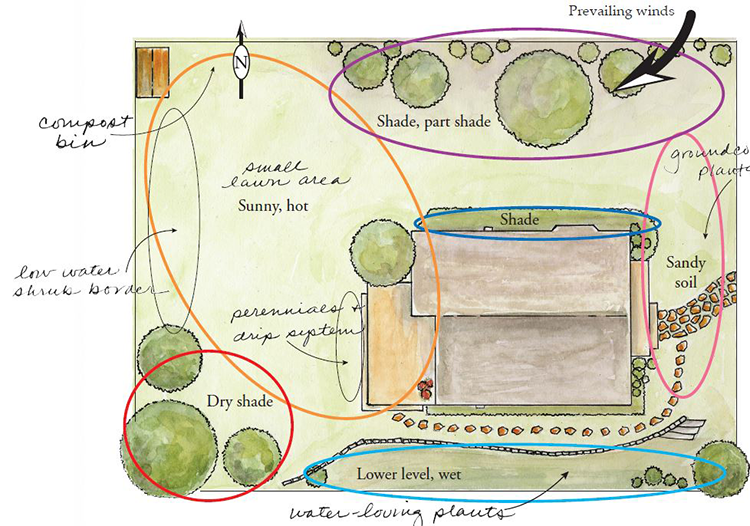Choosing the Right Plants for Your Site
You can save water, reduce the need for chemicals, and grow a beautiful easy-care yard by following these steps. Learn more in the Choosing the Right Plants Guide (pdf).
Get to know your yard
Where is it sunny or shady at different seasons? Dig in a few places to see where your soil is sand or clay, soggy year ‘round or bone dry. Look around – are there plants with problems? Where do you want play areas, vegetables, color, views, or privacy? How much lawn do you need, or want to maintain? What kind of plantings would fit your yard?
Choose the right plant for the right place
- Select plants that grow well in the Northwest and match the sun, soil, and water available in your yard.
- Considering edible plants? See Food Gardening.
- Think about how big a tree or shrub will be when mature (especially next to houses or under powerlines).
- Look around at neighbors’ yards, nurseries, and demonstration gardens for plants that do well in sites similar to yours. (See the publications and links below for more ideas.)
Pick plants that resist pests and use less water
Many pest and disease resistant varieties are available now – ask at nurseries or call the Garden Hotline. Choose plants that are “low water use” or “drought tolerant.” After they’re established (2-5 years), many will thrive just on our limited summer rainfall most years, saving you time and money on watering.
Group plants by their needs
Put plants that need full sun, or shade, or certain soil conditions, or frequent irrigation together with those with similar needs. That way you don’t have to water the whole yard to reach one thirsty plant!
Lawns and vegetables are picky!
They need several hours of full sun, level well-drained soil, and irrigation. Limit lawn areas to where you need them. Other plants are better for shade, soggy sites, or slopes, and require less maintenance. (See the lists below or call the Garden Hotline for ideas.)
Give plants a good start
- Prepare the soil by mixing 20-25% compost into soil in planting beds. (For trees and shrubs, mix compost into the whole planting bed, or just plant in native soil and mulch well. Don’t add compost just to their planting holes – that can limit root growth.)
- Then spread out the roots, add water, and tamp soil back in for good root contact. Set plants so the soil level is at the same height on the stem as at the nursery, to prevent problems.
- Mulch new plantings well, and be sure to water even drought tolerant plants during their first few summers, until they build deep roots.
- Learn more about tree planting and care at Trees for Seattle. See video Planting a Tree (video, 4 min.) or in Spanish Cómo plantar un árbol.
Make space for wildlife
You can invite birds, butterflies, and other wildlife into your yard, protect shorelines and salmon, and make a more attractive landscape. Plant trees and use native plants, especially ones with fruit and flowers. Plant in layers (ground cover, shrubs, and trees). Avoid using pesticides – they can poison birds, beneficial insects, and salmon when rain washes them through storm drains into streams. Leave wild “buffer” areas of native plants along ravines, streams and shorelines.
Learn more
Choosing the Right Plants (pdf) Learn how to plan your whole yard, and how to select plants that fit each site and need.
How to Water New Plants - Even “drought tolerant” plants need water at the start!
Tree Planting - The first step to a strong, healthy tree is proper planting. Read about the easy steps to make sure your tree gets the right start in life.
Plant Lists
- The Plant List (pdf) - 240 plants organized by the conditions they need; includes many native plants.
- Salmon Friendly Plants (pdf) - Lists native plants that provide habitat benefits, especially useful along streams and lakes, restoration areas, or for backyard wildlife stewards.
- Great Plant Picks - A wide variety of Northwest-adapted ornamental plants.
- King County Native Plant Guide - Native plant lists, plus landscaping plans and how-to articles.
- Washington Native Plant Society - Lists native plants for specific landscape conditions, including plants to attract wildlife.
- SDOT Street Tree List - SDOT approved list of small, medium, and large trees for your planting strip. Residents must obtain a permit before planting a street tree in Seattle.
Books
Two classics are The Sunset Western Garden Book (Sunset Publishing); and Right Plant, Right Place, by Nicola Ferguson (Summit Books, 1994). Visit your local public library or book-store, or call the Garden Hotline for more gardening resources.
Links to Other Sites
Noxious Weeds - (King County) Check this list and avoid these exotic, invasive plants.
